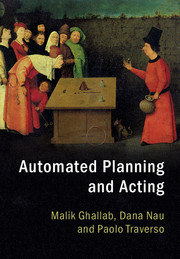Book contents
- Frontmatter
- Dedication
- Contents
- List of Algorithms
- Table of Notation
- Foreword
- Preface
- 1 Introduction
- 2 Deliberation with Deterministic Models
- 3 Deliberation with Refinement Methods
- 4 Deliberation with Temporal Models
- 5 Deliberation with Nondeterministic Models
- 6 Deliberation with Probabilistic Models
- 7 Other Deliberation Functions
- 8 Concluding Remarks
- Appendix A Search Algorithms
- Appendix B Strongly Connected Components of a Graph
- Bibliography
- Index
1 - Introduction
Published online by Cambridge University Press: 05 August 2016
- Frontmatter
- Dedication
- Contents
- List of Algorithms
- Table of Notation
- Foreword
- Preface
- 1 Introduction
- 2 Deliberation with Deterministic Models
- 3 Deliberation with Refinement Methods
- 4 Deliberation with Temporal Models
- 5 Deliberation with Nondeterministic Models
- 6 Deliberation with Probabilistic Models
- 7 Other Deliberation Functions
- 8 Concluding Remarks
- Appendix A Search Algorithms
- Appendix B Strongly Connected Components of a Graph
- Bibliography
- Index
Summary
This chapter introduces informally the concepts and technical material developed in the rest of the book. It discusses in particular the notion of deliberation, which is at the core of the interaction between planning and acting. Section 1.1 motivates our study of deliberation from a computational viewpoint and delineates the scope of the book. We then introduce a conceptual view of an artificial entity, called an actor, capable of acting deliberately on its environment, and discuss our main assumptions.Deliberation models and functions are presented next. Section 1.4 describes two application domains that will be simplified into illustrative examples of the techniques covered in rest of the book.
PURPOSE AND MOTIVATIONS
First Intuition
What is deliberative acting? That is the question we are studying in this book.We address it by investigating the computational reasoning principles and mechanisms supporting how to choose and perform actions.
We use the word action to refer to something that an agent does, such as exerting a force, a motion, a perception or a communication, in order to make a change in its environment and own state. An agent is any entity capable of interacting with its environment. An agent acting deliberately is motivated by some intended objective. It performs one or several actions that are justifiable by sound reasoning with respect to this objective.
Deliberation for acting consists of deciding which actions to undertake and how to perform them to achieve an objective. It refers to a reasoning process, both before and during acting, that addresses questions such as the following:
• If an agent performs an action, what will the result be?
• Which actions should an agent undertake,and how should the agent perform the chosen actions to produce a desired effect?
Such reasoning allows the agent to predict, to decide what to do and how do it, and to combine several actions that contribute jointly to the objective. The reasoning consists in using predictive models of the agent's environment and capabilities to simulate what will happen if the agent performs an action. Let us illustrate these abstract notions intuitively.
- Type
- Chapter
- Information
- Automated Planning and Acting , pp. 1 - 18Publisher: Cambridge University PressPrint publication year: 2016



